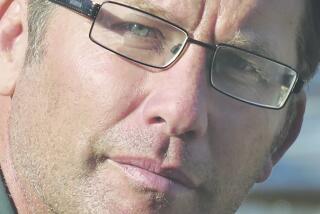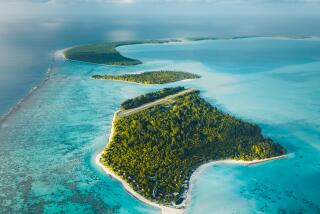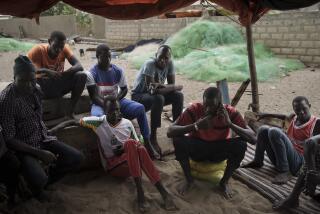Wet & Wild : Africa by Canoe : Gliding Among the Rich Wildlife of Botswanaâs Okavango Delta
MAUN, Botswana â Later I got used to not caring a damn, just to walking and staying put when I had walked far enough, at some village of which I didnât know the name, to letting myself drift with Africa. --Graham Greene, âJourney Without Mapsâ Drifting with the currents on Botswanaâs Okavango Delta, gliding through channels choked by papyrus and lily pads is like a journey without maps.
I found myself in unfamiliar territory, not caring about anything but sitting back and enjoying the sky, the clouds and the birds as our canoe passed red and yellow reeds, swamp grasses, sausage trees and fields of maize.
I watched wallowing hippos, heard the screech of baboons and, in the evening, fell asleep to a symphony of swamp sounds. I was not oblivious to the dangers of this watery wilderness, but it was hard to feel threatened in such pristine, even hypnotic, surroundings.
Before 1923 there were no comprehensive maps of the Okavango Delta, a lush waterway on the edge of the Kalahari Desert. Itâs nearly impossible to accurately map an area that changes so dramatically with the seasons.
The Okavango River, which begins in the Angola Highlands, swells during the rainy season (November to April) and floods over a depression in Botswana, forming the worldâs largest inland delta: 6,500 square miles of inlets, flood plains, lagoons and islands.
I went on a four-day water safari last May. It was a good time to visit. The Delta was in full flood, lush with vegetation, and the weather was dry and warm but never too hot.
I saw lots of wildlife, though I probably would have seen more at the end of the dry season in September and October when herds of animals come to the Delta in search of water.
Canoes, which are like water taxis, are the only way to get around much of the Delta. They transport people from village to village, to fishing or hunting areas. Polers are the taxi drivers, having grown up navigating the channels. They stand in the stern, moving the canoe forward with a long forked pole (a ngashi).
My journey began when two friends--Katie Janssen and John Blank--showed up at my door in Harare, Zimbabwe. They had just finished a year teaching in Kenyan villages. I was on a six-month trip to Harare, visiting a friend who works there.
Katie and John were driving through eastern and southern Africa and suggested a trip to the Okavango--the âSerengeti of Swampsâ they called it. I was game.
Itâs hard to stick to a timetable when youâre traveling in Africa in a â67 Land Rover. Every time we hit a rut I braced myself to avoid hitting my head on the roof. We stalled each time mud splashed on the spark plugs, which was often.
It took three days to make the 700-mile trip to the Delta. We passed through customs behind a huge bus of Zimbabweans going to Botswana to shop.
Later, Botswana soldiers stopped us at a roadblock. They were apparently making a routine check for South African secret agents who conduct undercover operations in Botswana, trying to find African National Congress guerrillas. They let us pass.
After a long drive along the northern edge of the surprisingly lush Kalahari Desert it was a relief to see water. We had reached Maun, the gateway to the Delta. Maun is a patchwork of old and new, with posh hotels going up next to traditional villages.
Herero women, refugees from Namibia, wander the streets dressed in colorful long dresses adopted from 19th-Century German colonists, but decorated with African patterns.
Our home base was 7 1/2 miles north of Maun at Island Safari Lodge. We shared a campsite with several South Africans speaking Afrikaans. They tried to convince us that apartheid doesnât exist, and that they werenât such âbad guys.â They regaled us with tales of traversing the African bush.
But we were more interested in water and canoes than Afrikaner tales. So we decided to hire a canoe and poler for four days through Island Safaris, at the lodge.
Kay Potter, who operates the lodge with her husband Phil, recommends using Fiberglas canoes rather than the traditional mokoros , which are carved from sausage trees.
âYou have to chop down a sausage tree to make a mokoro ,â she said . âBefore long the trees will be gone. Besides, you get a wet bum in a mokoro . I guarantee it.â We were to get âwet bumsâ anyway.
The next day a speedboat took us into the Delta. As we went deeper, the winding pathway through the lily pads grew narrower. The boatman moved expertly through the tortuous channels at breakneck speed. Every so often he would stop and reverse the motor, when the prop became clogged with reeds.
After two hours we reached an island inhabited by polers who were sitting around a fire making coffee in tin cans and cooking mielie meal. Mielie meal, the staple food in sub-Saharan Africa, is like thick grits. It fills you up but wonât put meat on your bones. A telltale sign: There wasnât an overweight man among the polers.
They didnât pay much heed to us when we arrived. But eventually Kenneth Monare, a tall, barefoot man wearing shorts and a blue T-shirt, approached us. He would be our pilot and guide for the next four days.
We were lucky. Kenneth spoke English and enjoyed practicing it with us. He also taught us a few Setswana phrases. Although English is the official language of Botswana, Setswana, a Bantu language of the Tswana tribe, is spoken by 90% of its population.
Monareâs friend Kid, a shorter man wearing a BMW jacket, piloted the other canoe in our party, which also included a Canadian couple who were traveling around the world.
When the polers were ready, we glided out into a channel bound for Chiefâs Island, the main island in Moremi Wildlife Reserve (set up by the Tswana tribe in 1962 to protect the animals) and one of the best game reserves in Africa.
Kenneth stood in the stern and began rhythmically poling us forward. The prow of the canoe parted the reeds that sprouted like stubble from the water. Sometimes a spider, while stretching a web between the reeds, would fall into our canoe.
The spiders were fat, dark and fuzzy, though non-poisonous. We would either toss them out of the canoe or carry them along with us to another part of the Delta. The webs were often so beautiful that I felt sad, as if we had destroyed a work of art.
The Delta is a palette of colors: yellow water lilies, white and pink flowers against the reeds, tiny green frogs on lily pads.
When we passed another canoe Kenneth would greet his fellow poler with a hearty âdumela!â (âhelloâ in Setswana). I marveled at how he could navigate the delta maze in which channels become dead ends clogged by vegetation. Some of the channels are kept open only because hippos break through the reeds.
We reached our first campsite on Chiefâs Island after three hours and a bit too much sun. Later, we took the canoe out to get water for cooking and to photograph the sunsets. The nights, what with the campfires and the stars, reminded me of my childhood camping trips.
When we were quiet we were treated to a cacophony of exotic sounds: the screech of baboons . . . hippo grunts . . . the plaintive songs of crickets, frogs, birds . . . an insect that sounded like the tinkling of a toy piano, and the eerie cackling of hyenas.
As we brushed our teeth we saw two yellow eyes of a bush baby, a nocturnal primate, staring at us through the trees.
The sounds of mosquitoes were considerably less exciting. I was glad that I was wearing mosquito repellent and taking anti-malaria medication. Malaria is the main hazard in the delta. Itâs unlikely that one would be bitten by tsetse flies, crocodiles, lions, leopards or poisonous snakes, but anyone who goes into the delta and doesnât take precautions against malaria is foolish.
In the morning Kenneth took us to another spot on the northern part of Chiefâs Island, a place that abounds with game. We passed a deep pool where hippos were wallowing. Kenneth and Kid kept their distance. I was aware that an angry hippo could smash a canoe to bits. But Kenneth, with typical African tour guide aplomb, said there was little danger.
âTheyâre very frightened,â he said, as a snort came up from a hippo. Nine times out of 10 heâs right. Of course Iâd hate to be too close on that occasion when a hippo does decide to charge.
As we approached our destination Kenneth and Kid found that the channel had shifted and was only a few inches deep. The thick swamp grasses made it impossible to move forward. After a futile effort, Kenneth gave us the command: âGet out!â
We rolled up our pants legs and began to push the canoes through the reeds. We splashed through the mushy swamp. Now, Iâm not one who particularly enjoys sticking his feet into swamp water. I had visions of leeches covering my calves. I feared it might be time for the crocodiles to have a picnic. I guess I identify more with Woody Allen than Indiana Jones.
We reached our campsite tired but exhilarated. I looked back at the area we had just crossed--a field of tans and yellows fading into the blue sky.
This part of the island was deserted except for the animals. We followed Kenneth on walking safaris. He led us for hours as he followed smells, tracks and droppings through the brown grass and gnarled trees. He had to quiet us several times to avoid frightening the animals.
At one point, after hours of walking, he put up his hand to halt us. Several zebra, wildebeest, tsesebe antelope and warthogs came out in front of us, no more than 10 feet away.
We were on the trail of an elephant. We could smell its musk-like odor but we never found it. I had seen elephants before, but always from the safety of a vehicle. I feared the possibility of coming face to face with one of the huge animals.
But we probably were safe in Kennethâs hands. He had a keen sense of the smells and sounds of the delta--where to go and, perhaps more important, where not to go. His calm and self-confidence was reassuring.
On our last night I realized why Kenneth wanted Kid to come along. They joked and laughed together, making the trip relaxed and fun for all of us. But Kid was also a master fisherman. He took a drop line, crouched by the waterâs edge and snared 20 fish.
Kid and Kenneth used four of the fish to make a stew for themselves, and saved the rest for their fellow polers. I feared that perhaps the fish would be the appetizer and we would be the main course for some predator--a leopard, baboon or hyena, whose jaws are said to be the strongest of all animals.
Indeed, hyenas are known to attack humans while they sleep, which is why itâs important to keep your tent flap zipped up. But in the morning the fish were still dangling on the line.
Kenneth showed us his calloused hands, which told the story of his years as a poler. The lodge pays him 5 pula (about $2.50) a day plus food. (Passengers are expected to tip their poler at the end of the trip.)
He told us that someday he would like to own his own mokoro. But you need to pay a teacher 200 to 300 pula to show you how to build one. Besides that, Kenneth had to think about saving enough pulas to someday pay for a bride. Payment to the parents of the bride used to be in cattle; now you can pay in pulas (or VCRs in some parts of Africa).
I was happy I didnât have to worry about a brideâs price. Then again, I would soon return to a complex world of jumbo jets and grid-locked cities, and somehow the life of the poler seemed more civilized and appealing.
As we rode back to the Island Safari Lodge in a powerboat at what now seemed like a frenetic pace, I hoped that there would always be room in this world for the polers, expertly plying the uncharted delta waters.
More to Read
Sign up for The Wild
Weâll help you find the best places to hike, bike and run, as well as the perfect silent spots for meditation and yoga.
You may occasionally receive promotional content from the Los Angeles Times.






